
 |
Tea Clipper |
 |
| from TeaAntiques.com | ||
| Edition Sixty Nine |
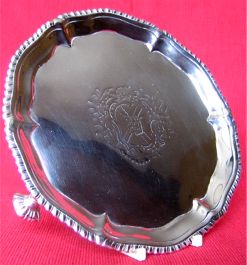 A
delightful and very elegant George III Waiter tray or 'salver'. This beautiful and
early piece of Silver was made in London by Ebenezer Coker, 1770. It is of the very
highest quality and of thick gauge silver and has a contemporary armorial in the
centre. There is no later decoration applied, which is very nice to see as so often
these are later embellished with chased decoration, thus making this a very desirable
salver.
A
delightful and very elegant George III Waiter tray or 'salver'. This beautiful and
early piece of Silver was made in London by Ebenezer Coker, 1770. It is of the very
highest quality and of thick gauge silver and has a contemporary armorial in the
centre. There is no later decoration applied, which is very nice to see as so often
these are later embellished with chased decoration, thus making this a very desirable
salver.
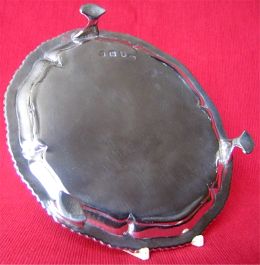 There
is a beautifully shaped rim border cast with simple and elegant gadrooned decoration.
In the centre of the salver there is a contemporary armorial, comprising a central
shield within a cartouche, this surrounded by foliate decoration.
There
is a beautifully shaped rim border cast with simple and elegant gadrooned decoration.
In the centre of the salver there is a contemporary armorial, comprising a central
shield within a cartouche, this surrounded by foliate decoration.
The salver is raised up on three cast bracket feet. These feet are well made and are very strong and stout. Each foot fans out to a curved rim, which like the rim of the salver tray, has beautiful gadrooned decoration. This style of foot is rather unusual, it being more common for such salvers to have 'hoof' or 'shell' shaped feet.
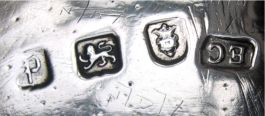 There
is a very clear and bold set of hallmarks stamped on the back of the waiter tray.
These marks comprise the maker's initials 'E.C' the mark of Ebenezer Coker; Lion
Passant mark for Sterling Silver; date letter of a 'p' for 1770 and the Leopard's
head mark of London's Assay Office.
There
is a very clear and bold set of hallmarks stamped on the back of the waiter tray.
These marks comprise the maker's initials 'E.C' the mark of Ebenezer Coker; Lion
Passant mark for Sterling Silver; date letter of a 'p' for 1770 and the Leopard's
head mark of London's Assay Office.
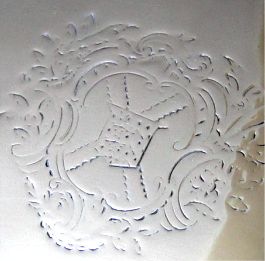
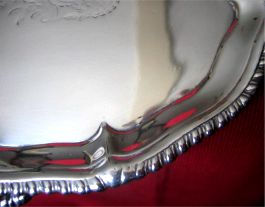
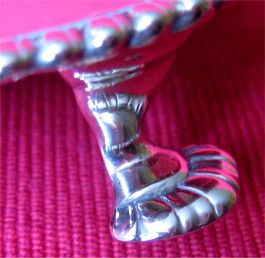
This is a fine salver for the collector of Georgian silver.
More details of this item and other tea related antiques can be found by visiting my web site at www.TeaAntiques.com.
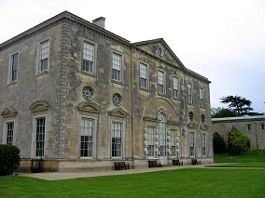 Sitting
in beautiful open Buckinghamshire countryside is the elegant Claydon house, with
its cut grey stone West front with perfect classical symmetry. The house appears
to be of perfect proportions having a central block surmounted with a triangular
pediment, flanked on either side with a two bay elevation. The enchanting features
of this elevation is the Venetian window in the centre which is within an arched
recess in the central block. Another unusual feature is the oval windows in the
two side wings placed above the ground floor sash windows.
Sitting
in beautiful open Buckinghamshire countryside is the elegant Claydon house, with
its cut grey stone West front with perfect classical symmetry. The house appears
to be of perfect proportions having a central block surmounted with a triangular
pediment, flanked on either side with a two bay elevation. The enchanting features
of this elevation is the Venetian window in the centre which is within an arched
recess in the central block. Another unusual feature is the oval windows in the
two side wings placed above the ground floor sash windows.
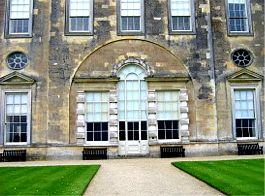 The
house, as we see it in part now, dates from 1751-1771, built by Ralph, 2nd
Earl Verney, whose family had lived in this seat since 1620. However, it becomes
quite evident from looking round the house that there is something odd about it.
There are just three extremely grand rooms along the West front, such large scale
and grandeur one would not expect in a country house of what appears rather modest
proportions. The answer is found in its later history, as Lord Verney's reckless
extravagances brought him to financial ruin in 1783 and in 1784 he had to sell off
a lot of the house contents. Then, on the Earl's death in 1791, his disapproving
niece had two thirds of the house demolished! So, what we see today as a classically
proportioned house, is in fact one of the side wings of a much larger house. These
two wings were joined by a large Rotunda in the centre. This then makes sense of
the house layout that we see now. How grand a house it must have been before the
demolition of a major part of it!
The
house, as we see it in part now, dates from 1751-1771, built by Ralph, 2nd
Earl Verney, whose family had lived in this seat since 1620. However, it becomes
quite evident from looking round the house that there is something odd about it.
There are just three extremely grand rooms along the West front, such large scale
and grandeur one would not expect in a country house of what appears rather modest
proportions. The answer is found in its later history, as Lord Verney's reckless
extravagances brought him to financial ruin in 1783 and in 1784 he had to sell off
a lot of the house contents. Then, on the Earl's death in 1791, his disapproving
niece had two thirds of the house demolished! So, what we see today as a classically
proportioned house, is in fact one of the side wings of a much larger house. These
two wings were joined by a large Rotunda in the centre. This then makes sense of
the house layout that we see now. How grand a house it must have been before the
demolition of a major part of it!
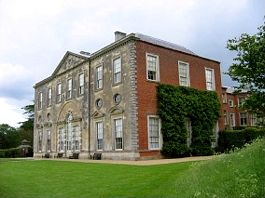
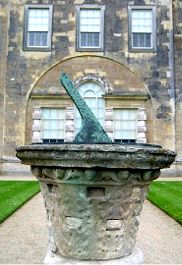
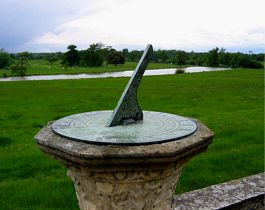
The visitor enters the house via the Pink Parlour, which is now also the entrance hall to the back left of the house. Turning right from this room you enter the first of the very grand room of three rooms along the West elevation. Each of these rooms is formed of a double cube, 50 feet long, 25 feet wide and 25 feet high, giving them their perfect classical proportions. This first grand room since 1862 has served as the North Hall, but in the original larger house layout, was the 2nd Earl's Great Eating Room. This would have led off the now demolished central Rotunda of the house. The first thing that hits you as you walk into this room, apart from the scale, is the astounding wood carved decoration applied liberally around the room, all painted white to make it look like fine plaster work. This magnificent carved wood decoration is the work of Luke Lightfoot, who was obviously an eminent Eighteenth century wood carver as well as a brilliant stonemason brought in to build Claydon House after working on the 2nd Earl's London home.
Lightfoot's wood carved decoration in elegant rococo design is applied to the door cases, around niches in the walls as well as to the ceiling decoration. Many of the carvings including birds and dragons together with the usual rococo scrolls and foliage. The four wall niches contain white busts who represent the four continents of Europe, Asia, America and India. The ceiling is divided into three sections. the central section includes the central boss of foliage from which would have hung a massive chandelier. To either side of this central section are two sections containing military decoration and includes spears, muskets and cannons, also the Verney crest of a Phoenix. The walls of the room are in a pale yellow which is a perfect soft foil for the white carved wood decorations creating an extremely elegant room.
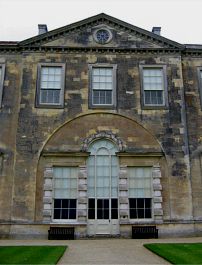 Moving
through to the central room of the three is the Saloon. Here there is still the
magnificence as found in the North Hall with more elaborate carved and applied decoration,
but this time not rococo, but pure Palladian splendour. This room is decorated with
a blue - grey flock paper that was put up in 1957 to a copy of a Georgian flock
paper. The ceiling is richly embellished with Neo-classical stucco decoration painted
in white. Even the doors in the room are decorated, rather unusually, with panels
that have raised shell type mouldings, with inlays of boxwood and ebony. Each corner
of the panels is set with ivory whose pure white stands out against the rich dark
mahogany.
Moving
through to the central room of the three is the Saloon. Here there is still the
magnificence as found in the North Hall with more elaborate carved and applied decoration,
but this time not rococo, but pure Palladian splendour. This room is decorated with
a blue - grey flock paper that was put up in 1957 to a copy of a Georgian flock
paper. The ceiling is richly embellished with Neo-classical stucco decoration painted
in white. Even the doors in the room are decorated, rather unusually, with panels
that have raised shell type mouldings, with inlays of boxwood and ebony. Each corner
of the panels is set with ivory whose pure white stands out against the rich dark
mahogany.
For me, an interesting feature in the room was the huge marble chimneypiece.
Executed in white marble, it tells the story of the development of the Corinthian
order, as described by Vitruvious. The chimneypiece has two supporting figures one
on either side. The one to the left side is a grieving female figure. She is clutching
a basket which she had left on a young girl's grave.
This
basket is covered with acanthus leaves that had grown up round it - this the inspiration
of the Corinthian column capital. The male figure supporting the right hand side
of the chimneypiece is of an inventor. He is holding the base of a broken column
in one hand and in the other a pair of dividers, these symbolic of the girl's untimely
death and his craft. The inner frieze of the chimneypiece has carved putti
in various attitudes. One putti is carrying the mask tragedy, another a basket,
while one in the centre carries a portrait of the dead girl.
Sadly, there is little furniture in this room, due to the massive selling off of the house furniture in the late eighteenth century. There is a set of gilt framed open arm-chairs, each with an embroidered seat of differing designs worked by the members of the Verney family in the 1850's.
The third grand room of the North Front is the Library. The style of decoration is Neo-classical with the same sort of attention to exuberant applied decoration. The bookcases around the walls were moved to this room from another part of the house in 1861-2. On the floor is a superb Wilton carpet, this bought from the Great Exhibition in London in 1851 at a cost of £100.
Leaving the Library through a door to the back of the room and turning left along a narrow lobby, you enter the staircase or Black and White Hall. The extravagance in creating this magnificent staircase hall is immediately evident. The profusion of rich decoration, which is detailed in all aspects of the hall are just breathtaking. The rectangular cantilever staircase effortlessly makes its way up to the second floor and in the ceiling in the centre a huge oval glass lantern allowing light to flood into the stair way.
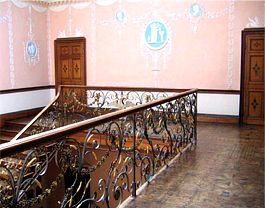
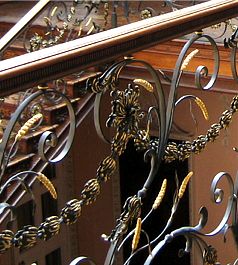 The
staircase of wood, has a Geometric inlay to each tread and riser. This decoration
is also applied to the handrail of the stair banister. But one of the most unusual
and charming feature of the staircase has to be the delicate wrought iron balustrade.
This is formed in three dimensions of a series of 'S' scrolls with floral garlands
entwined with fragile looking stems of wheat. This balustrade is painted black but
has gold flashings applied to the garlands and ears of wheat that make them shine
out. So delicate is the balustrade that in walking up the stairs the vibrations
make the staircase sing, the noise made by the vibrating ears of wheat knocking
parts of the balustrade. Sadly, visitors are not afforded the opportunity to ascend
this grand staircase, but have to make their way to the first floor by a modern
and very modest staircase off the Pink Parlour.
The
staircase of wood, has a Geometric inlay to each tread and riser. This decoration
is also applied to the handrail of the stair banister. But one of the most unusual
and charming feature of the staircase has to be the delicate wrought iron balustrade.
This is formed in three dimensions of a series of 'S' scrolls with floral garlands
entwined with fragile looking stems of wheat. This balustrade is painted black but
has gold flashings applied to the garlands and ears of wheat that make them shine
out. So delicate is the balustrade that in walking up the stairs the vibrations
make the staircase sing, the noise made by the vibrating ears of wheat knocking
parts of the balustrade. Sadly, visitors are not afforded the opportunity to ascend
this grand staircase, but have to make their way to the first floor by a modern
and very modest staircase off the Pink Parlour.
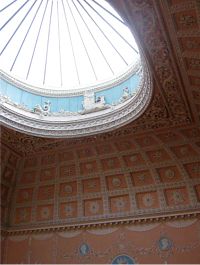 At
the first floor level the first room, which is directly above the Pink Parlour is
the Great Red Room. Not as grand as the three principle rooms on the ground floor,
but still retaining a sense of richness. Having three domes within the ceiling,
this room may have originally have been a principle bed chamber in which a four
poster bed would have been positioned with a large dome that would be below the
dome in the ceiling. One door in the corner of the room affords a good view of the
staircase ceiling lantern.
At
the first floor level the first room, which is directly above the Pink Parlour is
the Great Red Room. Not as grand as the three principle rooms on the ground floor,
but still retaining a sense of richness. Having three domes within the ceiling,
this room may have originally have been a principle bed chamber in which a four
poster bed would have been positioned with a large dome that would be below the
dome in the ceiling. One door in the corner of the room affords a good view of the
staircase ceiling lantern.
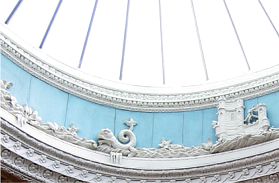 Around
this lantern is a blue and white frieze depicting Neptune.
Around
this lantern is a blue and white frieze depicting Neptune.
On this the first floor there are a variety of rooms that include a Museum room, containing the family's curiosities from around the world. There is also some memorabilia relating to Florence Nightingale, the famous 'lady of the lamp' nurse from the Crimea war. Florence Nightingale was a relation by marriage to the Verney family. One room that you see is Miss Nightingale's bedroom. It was here that Florence would stay during her many visits to Claydon House between 1857-1890. Her horse drawn carriage can be seen housed in one of the garages of the service area behind the house.
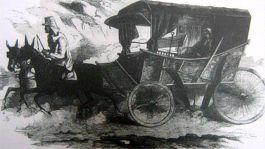
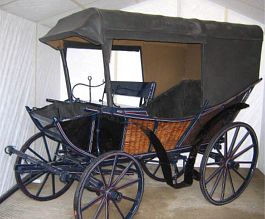
From Miss Nightingale's room you make your way to the front of the house again to the three rooms which are above the three grand rooms, on the ground floor. The first of these rooms is the Gothic or Blue Room, so named because of the decorative taste of this room is Gothic in blue and white colours. Used from the 1860's as a boudoir for the ladies, this was probably originally a very grand bedroom. the decoration around the room is executed in carved wood pained white to resemble plaster. there is a repeated motif within the decoration of a triple arched pavilion. This pavilion is noticeable in the central ceiling recess, the door cases and chimneypiece. On the walls are a fine set of six very interesting Chinese 'export' paintings showing various scenes from supposed everyday life in China in the eighteenth century. 'Supposedly' everyday life in China because these were painted for the European market and so painted to show how the Europeans imagined life in China to be. Interestingly one of the paintings appears to depict a group taking or tasting tea.
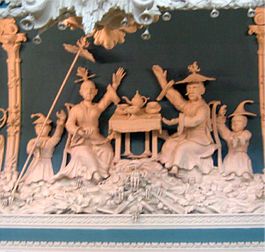 Continuing
a tea theme, the next room, the Chinese Room was of most interesting to me. This
glorious room is decorated to look like a Chinese room and looking rather out of
place in an English country house. The room is decorated in blue with white carved
decoration, rather reminiscent of the export blue and white Chinese porcelain of
the period. There are bright gold curtains and this used to cover the seat furniture
too. On the long wall of the room is what is described as a day-bed within a carved
white Chinese Tea pavilion. This astounding decorative piece of furniture was decorated
to show the tea ceremony, which echoes what it was designed for - taking of tea.
Continuing
a tea theme, the next room, the Chinese Room was of most interesting to me. This
glorious room is decorated to look like a Chinese room and looking rather out of
place in an English country house. The room is decorated in blue with white carved
decoration, rather reminiscent of the export blue and white Chinese porcelain of
the period. There are bright gold curtains and this used to cover the seat furniture
too. On the long wall of the room is what is described as a day-bed within a carved
white Chinese Tea pavilion. This astounding decorative piece of furniture was decorated
to show the tea ceremony, which echoes what it was designed for - taking of tea.
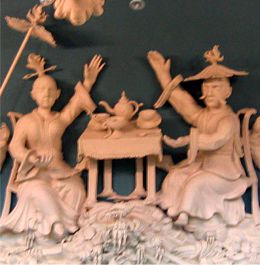 The
carved wood above the seat shows two Chinese mandarins taking tea at a tea table,
assisted by two other Chinese characters, one holding a shade. It is fascinating
to see the tea equipage carved on the tea table. There is a globular teapot of the
period, two tea bowls and saucers, teaspoons and a footed sugar bowl in which are
a pair of sugar nips in the form of fire iron tongs. The tea table is covered with
a white tablecloth. This carving gives us another insight into the social history
of tea drinking and its importance in the social world in the Eighteenth century.
The
carved wood above the seat shows two Chinese mandarins taking tea at a tea table,
assisted by two other Chinese characters, one holding a shade. It is fascinating
to see the tea equipage carved on the tea table. There is a globular teapot of the
period, two tea bowls and saucers, teaspoons and a footed sugar bowl in which are
a pair of sugar nips in the form of fire iron tongs. The tea table is covered with
a white tablecloth. This carving gives us another insight into the social history
of tea drinking and its importance in the social world in the Eighteenth century.
The final room on the first floor of the North front is an exhibition room, which includes a model which shows how the house looked when it was built with the two wings built on the sides of a central grand rotunda. There are also some architectural drawings of the house as it was originally.
This really was one of the most fascinating houses that I have had the pleasure to visit. The decoration of the grand interior with its carved wood is second to none. The Chinese room with its tea pavilion had to be the icing on the cake. I am sure that if you get a chance to see this beautiful English country house for yourself, you too will be astounded by its beauty.
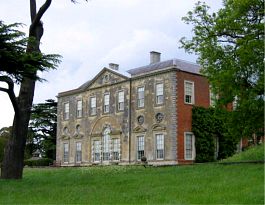
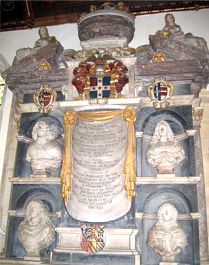
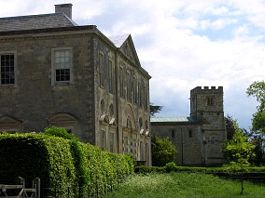
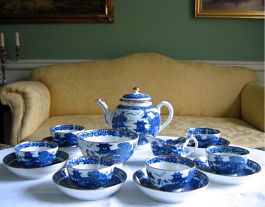 I
have recently obtained a fascinating part teaset. This beautiful Caughley teaset,
which dates from c1780-85 is unusual in many respects. Firstly, Caughley produced
many tea sets decorated with blue and white patterns in the oriental style, such
as the 'Fence' pattern, 'Pagoda' pattern and 'Fisherman and Cormorant' pattern to
name a few. Such patterns were also used at the Worcester factory in this period,
these may have some slight differences, but they are essentially the same. However,
there is one rare pattern produced at the Caughley factory in Shropshire, that was
never used at the Worcester factory - this is the 'Fenced Garden' pattern.
I
have recently obtained a fascinating part teaset. This beautiful Caughley teaset,
which dates from c1780-85 is unusual in many respects. Firstly, Caughley produced
many tea sets decorated with blue and white patterns in the oriental style, such
as the 'Fence' pattern, 'Pagoda' pattern and 'Fisherman and Cormorant' pattern to
name a few. Such patterns were also used at the Worcester factory in this period,
these may have some slight differences, but they are essentially the same. However,
there is one rare pattern produced at the Caughley factory in Shropshire, that was
never used at the Worcester factory - this is the 'Fenced Garden' pattern.
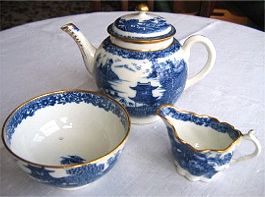 Another
intriguing piece of history to this delightful teaset is that it is believed to
have remained in one family since it was made back in the last quarter of the eighteenth
century. It is said to have belonged to the Cawley family who lived in Cheshire,
England. One of the family has now sold it on with the history of the set as far
as can be recalled. It is believed to have remained in this family and can certainly
be remembered back several generations.
Another
intriguing piece of history to this delightful teaset is that it is believed to
have remained in one family since it was made back in the last quarter of the eighteenth
century. It is said to have belonged to the Cawley family who lived in Cheshire,
England. One of the family has now sold it on with the history of the set as far
as can be recalled. It is believed to have remained in this family and can certainly
be remembered back several generations.
The part tea set is not complete, but does have a fine selection of the pieces that would have gone to make up the service. There is a round smooth bodied teapot and cover, sugar bowl, 'Chelsea Ewer' shaped creamer and six tea bowls and saucers. Not all these pieces are in good condition, but there are four of the tea bowls and saucers that are in extremely good condition - these are now available for sale on the website. Click here for a lot more details about them.
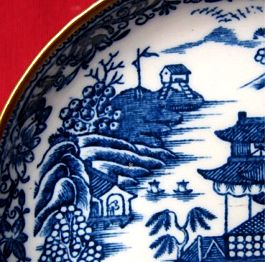
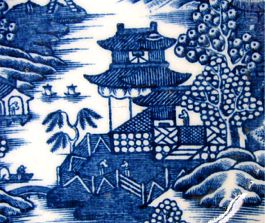
The 'Fenced Garden' pattern is so named as the main blue and white scene depicts a large oriental Pagoda type of building with a fenced off garden in front of it. Within this fenced garden are two figures conversing. The land on which this building is situated has rocks and different varieties of trees. The secondary scene is an Island on which is a curious building raised up on stilts at the top of the Island. Other interesting features of this scene is the boat house with a boat emerging, another building with a figure at the door, rocks and trees. This Island is joined to the main scene by a bridge. Two boats can be seen sailing the sea between the two main scenes completing this charming picture.
There is a blue border comprising a garland of flowers and foliage. The blue used for this service is an attractive dark and striking blue.
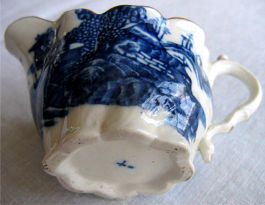 Many
of the pieces in this set are marked in under glaze blue with the Caughley Salopian
'S' or 'Sx' . these factory marked were used at Caughley between c1775 -90.
Many
of the pieces in this set are marked in under glaze blue with the Caughley Salopian
'S' or 'Sx' . these factory marked were used at Caughley between c1775 -90.
For me, one of the unusual things about this tea set is the 'Chelsea Ewer' shaped creamer. This very pretty little creamer is quite small compared the usual type of milk jug associated with most tea sets. I am sure that it was bought en suite to the tea set when it was originally purchased. It has an interesting moulded body shape, including moulded leaves up from its base. The handle is constructed using two 'C' scrolls with a charming thumb piece at the top to aid holding it.
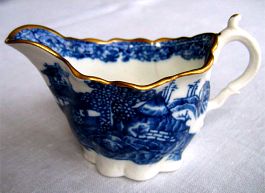
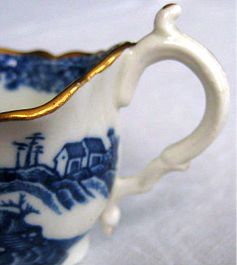
It is wonderful to see such a beautiful service with so many interesting pieces. It is a bonus that this set is of the rare 'Fenced Garden' pattern and I hope that you have enjoyed seeing sharing this set with me.
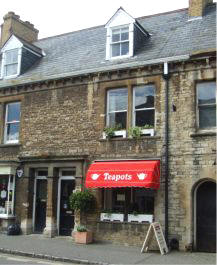
The
quaint town of Olney in Buckinghamshire is well known in the area for its annual
pancake race and its lace making. There is also, as I discovered, a very pleasant
little tea shop in the town in which to enjoy an afternoon tea, with home-made cakes.
'Teapots' is on the High Street a short distance from the town's triangular green. It is a friendly little tea shop with an interesting character. There is an eclectic sense of decoration, including a display of old ladies' hats on the stairs up to the top floor. In the first floor room, there is an old fireplace on which sits an old mantle clock, which ticks away and chimes at regular intervals. There are a few odd teapots dotted about, including novelty teapots. In frames are some examples of the old local white lace.
On the ground floor at the rear of the shop, an old-fashion sideboard carries a selection of home-made cakes, including lemon sponge, ginger sponge, coffee sponge, carrot cake, etc. It is nice to see such a fine selection of homemade cakes. In this instance, I plumped to have a slice of ginger sponge cake, which was very good. The tea is served in china pots and the cups and saucers are of of blue and white china adding to the traditional English teashop look.
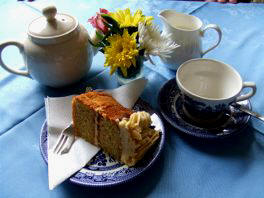
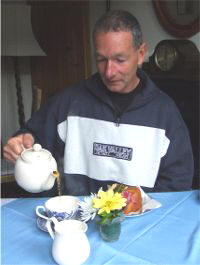
Olney town, apart from some fine houses and buildings, also hosts a few antique shops of various quality. The 'Teapots' teashop is a good place to sit and contemplate any antique purchases.
Local Map: click here
Map courtesy of www.streetmap.co.uk
To review past newsletters, just follow this link:
Past newsletters.
To subscribe to this free newsletter -
Click here